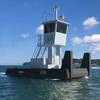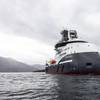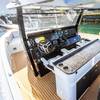The tightening of port security in the United States has impacted practically every vessel that operates in U.S. harbors. That includes the small, often-forgotten pilot boats that transport state licensed pilots to vessels entering a harbor or waterway. With recently imposed security measures mandating large ships wait further outside a harbor or waterway, pilot boats in some cases must travel twice as far before the pilot transfer can take place, according to Winn Willard of C. Raymond Hunt Associates, Boston, Mass., designers of pilot boats with 25 years experience in the field. — by Larry Pearson
Gladding Hearn:
A Quartet of Pilot Boats
Gladding Hearn, Somerset, Mass. is one of the busiest shipyards in the nation. The East Coast licensee for Incat Designs of Sydney, Australia, Gladding Hearn builds several aluminum fast ferries a year as well as research craft and pilot boats. Gladding Hearn has been building pilot boats for more than two decades. The popularity of their "Delaware Class" of deep V hulls designed by Hunt have been used extensively by pilot associations on the east and gulf coasts.
Following the Delaware class has been the St. John and Cape Fear classes of vessels that represent subtle but important refinements over the Delaware class. Increasing of hull deadrise forward gives a smoother ride while pushing spray to the side. Increased insulation in the engine room and beneath the main deck has resulted in a quieter vessel.
"The new Hunt-designed Chesapeake Class of 52-ft. pilot boats continues Gladding Hearn's tradition of refinements of our basic design," said John Duclos, vice president of the firm. "These are not changes for changes sake but are real advancements in pilotboat design," Duclos added.
Duclos mentioned electrically heated windows, hot water heated hand rails and main decks to prevent the formation of ice on critical surfaces plus a raised cabin with more freeboard and an aft station for use in emergency man overboard situations are just a few examples of the design enhancements over the years.
Presently Gladding Hearn is working on four 52-ft. all-aluminum pilot boats.
The first of the four vessels was delivered to the Associated Pilots of Maryland in September. A similar vessel will be handed over to the Virginia Pilots this year. Next year the Maryland Pilots will get a second vessel and the Tampa Bay Pilots will get one as well.
"These four vessels differ in minor details," Duclos said. "For example, the Maryland Pilots and the Virginia Pilots prefer Detroit Diesel engines while Tampa Bay specified Caterpillar for diesel power," Duclos added. Subtle changes in the pilothouse shape are also evident and are based on the prior operating experience of the three different pilot associations
The Maryland vessel delivered in September was called the Patapsco The 52-ft. six-in. vessel has a 17-ft. beam and a four-ft., eight-in. draft. A pair of Detroit Diesel series 60 engines rated at 600 hp at 2,100 rpm can drive the vessel to 25 knots.
A Northern Lights 10 kW generator supplies ship's electrical power. The main deck cabin contains three high back reclining pilot seats and is fully heated and cooled.
Interior sound level is less than 80 Dba and the vessel has a range of 300 miles at full power.
The second Maryland pilot boat will be called the Patuxent and will be a sister ship to the delivered vessel.
The boat for the Virginia pilots is very similar except for minor differences in the superstructure. For example, the Maryland pilots prefer windows that angle in from top to bottom while the Virginia pilots have pilothouse windows angling outward. There are also subtle differences in the design and layout of the stern rescue station, but engines, the generator and other mechanical systems are the same, as is rated speed and the Mate Saver rescue system. The Virginia Pilots vessel is unnamed as of yet and will be delivered during the last quarter of 2002. The last vessel in the series goes to the Tampa Bay Pilots. It uses Caterpillar 3406E propulsion power plants rated at 600 hp at 2,100 rpm. This vessel also uses tires for fendering.
Gladding Hearn also has several Incat 43-44 m fast ferry vessels under construction as well as a 65-foot coastal research vessel for Old Dominion University and a research vessel for the Wood's Hole Oceanographic Institute.
Kvichak Marine Builds
72-footer for Texas
The Sabine Pilots Association supply pilots to the Gulf Coast Texas ports of Beaumont, Orange, Port Arthur and Sabine and to many private terminals along the Sabine-Neches Waterway. These 24 pilots operate their pilot transfer vessels on a year around basis.
Kvichak Marine Industries, Seattle, Wash. has contracted to build a 72-ft. all aluminum pilot vessel for the Sabine Pilots for delivery in early 2003. The vessel is similar to the Chinook, a 72-ft. vessel that Kvichak delivered last year and operates on the Columbia River Bar in Washington State. Major difference between two vessels is the Chinook was designed as a self-righting craft to handle the serious and heavy seas commonplace on the Columbia Bar. Self-righting capability is not needed for the Sabine Pilots vessel.
The vessel is powered by a pair of Detroit Diesel 16V2000 engines rated at 1,285 hp at 2,300 rpm. The engines are connected to a pair of Hamilton HM 651 waterjets with 26-in. impellers through Detroit Diesel DD66195C reduction/reversing gears. The waterjets drive the vessel to a top speed of 28 knots, a cruising speed of 26 knots and afford excellent maneuverability as well.
Camarc Ltd. of the U.K. designed the vessel. Camarc has designed several pilot boats for Kvichak.
The "Popsafe" fendering system, patented by Camarc is used on this vessel. This system protects the vessel's hull during pilot transfers. The combination of a jet guard and a stern platform will assist pilot recovery in a man overboard situation. A forward raised pilot boarding platform assists in pilot transfer and handrails are placed so the pilot may move any where on deck and still maintain a grip on at least one handrail.
The new vessel also includes a Northern Lights 32 KW generator, 1,600-gallon fuel tank, six Beurteaux pilot seats on a raised platform in the main cabin plus day galley and crew accommodations. The galley contains a refrigerator, separate freezer, microwave, sink, water cooler and a two-burner cook top.
Steering is hydraulic with two independent systems operating off the two jet input shafts. An electronic system acts in a backup mode. A 60,000 BTU reverse cycle air conditioning systems heats and cools the vessel superstructure.
Kvichak is also building a pair of 39-ft. fireboats for the City of Los Angeles and a 54-ft. patrol boat for the California Fish and Game Department.
A Pilot/Push Boat from Geo Shipyard
The most unique pilot boat delivered this year is from one of the smaller shipyards in the country … Geo Shipyard, Inc. of New Iberia, La. Geo specializes in aluminum catamarans, typically for ferry boat or excursion service. "We were approached by a marine surveyor to quote a very unusual boat design, a combination pilot and push boat," said David LeCompte, vice president of Geo. The boat owner/operator was Kaiser Jamaica Bauxite. They load bauxite onto large ships and needed a vessel that could deliver pilots to the ships and then follow the ships to assist in docking. "The ships drop a bow anchor and the small boat then pushes the bauxite ore carrier by the stern in a circular track until the big ship is along side the dock," LeCompte added.
At this point the empty ore carrier is filled with bauxite and the ship sails to Gramercy, La. where the ore is refined into aluminum.
The Kaiser dock is located in Discovery Bay, the site of Christopher Columbus' landing. Waters can get rough in the bay so Geo suggested that a catamaran design be considered because of the ability of a catamaran to handle rough water.
Schuller and Allan, the Houston, Texas-based naval architect and design engineering firm confirmed that a combination pilot/push boat would meet the needs for docking assist as well as pilot delivery.
The vessel uses a Luggar 6125 diesel engine in each catamaran hull. Southern Power in Houma supplied the engines that develop 425 hp each at 2,300 rpm. Those engines work into ZF gears at a 2:1 ratio and drive 30- by 27-in. five-blade props. The vessel can operate at 18 knots, delivering pilots to the waiting vessels in a few minutes.
Called the Rhodes Star, the 40.3-ft. vessel can seat six pilots comfortably in the main deck cabin. The vessel is fitted with a bridge on top of the pilothouse for pilot transfer. The boat has a 16.25-ft. beam and draft of almost four feet.
Marine Air supplied a 12,000 BTU air conditioning system.
"The Rhodes Star has exceeded customer expectations," LeCompte added. "The specs called for a bollard pull of 7,200 pounds and the boat tested at 11,200 pounds," LeCompte said. The projected speed was also exceeded by over three knots.
Geo has been busy with several different aluminum catamaran projects this year. They delivered the Spirit of Lahaina to Hawaii, a 149-passenger excursion/ferry vessel and have a 27-foot sport fishing vessel in their fab shed at the moment.
Featured videos

Inmarsat Enhances Service to Drive Digitalization

Inside the Electrified Truckable Tug

Tracking Foreign Vessels Working in the U.S. Jones Act Market
Subscribe for
Maritime Reporter E-News
Maritime Reporter E-News is the maritime industry's largest circulation and most authoritative ENews Service, delivered to your Email five times per week









